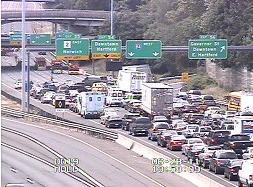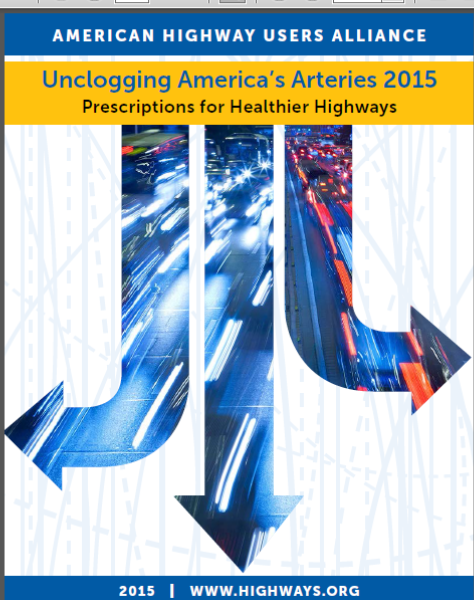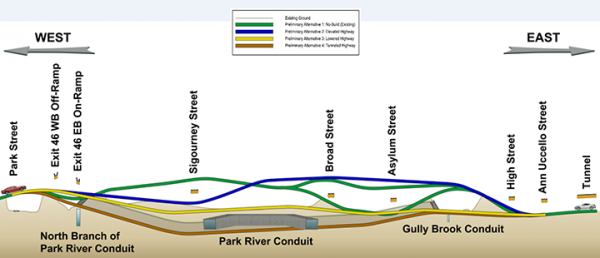Hartford, Stamford Among Nation's Most Congested Highways
/A new study by the American Highway Users Alliance identifies America’s 50 worst bottlenecks and finds that the very worst bottleneck, as measured by hours of delay, is in Chicago, IL. Los Angeles, CA owns the next six of the top 10. While Connecticut’s highways did not reach the top 50, two bottlenecks did receive honorable – or dishonorable – mention.
The I-84 section in Hartford between Trumbull Street and Park Street, and the I-95 section in Stamford between Fairfield Avenue and Elm Street, both made the list of 43 “Other Zones of Congestion” in the U.S. -thereby earning status as among the nation's 100 most congested traffic tie-ups. According to the data, the average length of the back-up in Hartford is 1.4 miles; in Stamford 1.3 miles. The average total annual delay at the Hartford bottleneck is 705,000 hours; in Stamford 494,000 hours of lost productivity.
Speaking at the American Highway Users Alliance press conference where the report was released, U.S. Transportation Secretary Anthony Foxx said, “This report furthers the unassailable truth that America is stuck in traffic. The good news is that this problem is solvable, and Congress can be part of the solution. As a long-term surface transportation bill moves through conference, I urge our elected leaders to provide the funding growth and policies that are necessary to improve commutes, to raise the bar for safety, and to keep the country moving in the 21st century.”
Hartford and Stamford were among 43 “zones of congestion” around the country that were noted in the report in addition to the top 50. The report indicated that “although congested, the worst segments of highway do not have the same severe delays/mile as the nationally ranked bottlenecks.” They are, the report points out, in many cases “the most congested in their states.”
I-84 in Hartford may be receiving a re-make over the next decade. The Department of Transportation is in the midst of determining the preferred option among three possibilities - to replace the I-84 raised viaduct or replace it with a ground-level highway or dig a tunnel. The various options have been presented in a series of public meetings in recent months, and a decision is anticipated early next year.
 The work, which has yet to be funded, is likely to include moving or eliminating some exits and entrances – and possibly adding others in new locations - to improve traffic flow. Cost estimates range from $4 billion to $12 billion, depending on the option selected. Upcoming public meetings are to be held in East Hartford on Dec. 2 and Hartford on Dec. 10.
The work, which has yet to be funded, is likely to include moving or eliminating some exits and entrances – and possibly adding others in new locations - to improve traffic flow. Cost estimates range from $4 billion to $12 billion, depending on the option selected. Upcoming public meetings are to be held in East Hartford on Dec. 2 and Hartford on Dec. 10.
In the top-ranked Chicago traffic bottleneck highlighted in the report, the Kennedy Expressway (I-90) between the Circle Interchange (I-290) and Edens junction (I-94), was found to extend 12 miles, costing motorists 16.9 million hours’ worth of time, equivalent to $418 million in 2014. More than 6.3 million gallons of fuel is wasted on I-90 while cars idle or crawl in traffic.
Besides identifying and ranking the nation’s 50 worst traffic bottlenecks, the study, Unclogging America’s Arteries 2015, examines the top 30 chokepoints closely and details many of the major benefits that will accrue to society by fixing them. In addition to improving mobility and quality of life for motorists, the report indicated that fixing the top 30 bottlenecks alone would, over 20 years:
- Save $39 billion due to lost time,
- Save 830 million gallons of fuel,
- Reduce over 17 billion pounds of greenhouse gas emissions (CO2), and
- Prevent 211,000 vehicle crashes
“These findings are critically important and mean that our nation will derive huge benefits from fixing the worst gridlock in our nation’s highway system: benefits that go way beyond improving mobility for highway users,” states Greg Cohen, President and CEO of the American Highway Users Alliance.
Amongst the top 10 was New York City with the 8th and 9th worst bottleneck at the notorious Lincoln Tunnel and on I-95 from Manhattan across the Bronx. Metropolitan New York also had the 18th, 19th, 21st, 31st, 33rd, 37th, and 42nd – ranked chokepoints.
As for the bottlenecks themselves, the study’s top 50 list includes trouble spots in the following Metropolitan Areas: 12 in Los Angeles, 9 in and around New York City, 3 in Chicago, 3 near Washington DC, 3 in Houston, 3 in Boston, 3 in Dallas, 3 in Miami, 2 in Atlanta, 2 in Philadelphia, and 2 in San Francisco/Oakland.
The report notes that bottlenecks can be fixed and points to specific chokepoints that have been addressed and, as a result, were not included in the rankings. Projects cited include the Woodrow Wilson Bridge replacement on I-495 in the Washington, DC area, the Marquette Interchange in Milwaukee, and the Katy Freeway reconstruction in Houston.





























